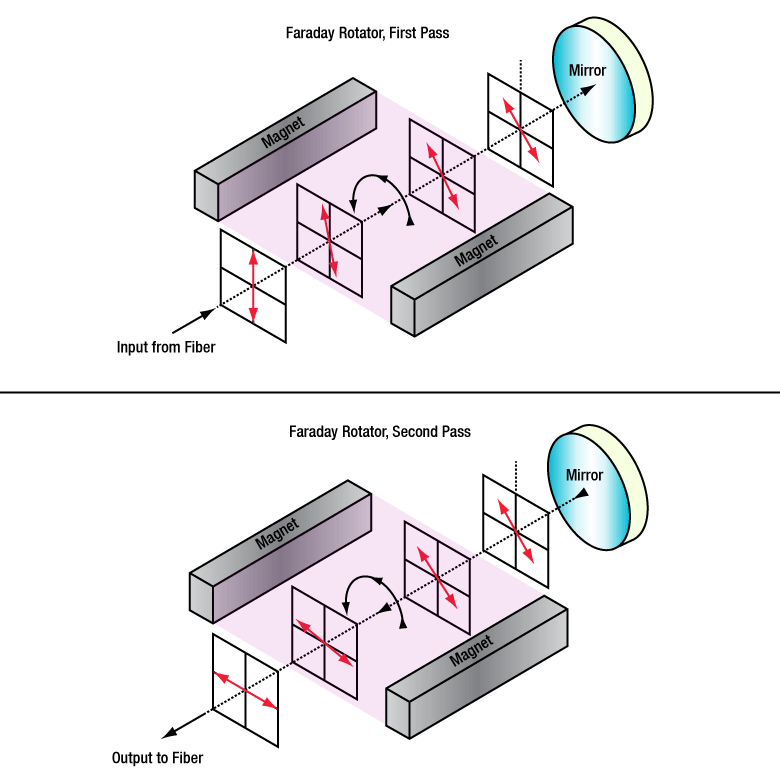Michelson proposed an interferometric apparatus in 1890 following an earlier suggestion by Fizeau. The invention became the precursor of many important modern optic measurement techniques. The Michelson Interferometer, as it is called, is used to measure small optical path length changes. The classic Michelson Interferometer consists of two mirrors (one forming the reference arm and the other the probing arm) and a 45-degree beam splitter. The reflected reference beam and the probing beam interfere with each other as they reach the beam splitter assuming there has not been any change in the state of polarization in either beam.
The drawback of the free space Michelson Interferometer is that the mirrors require constant adjustment for optimum beam overlap. A fiber optic Michelson Interferometer, however, requires no adjustment to the mirrors since the beam is confined in the optical fiber, the mirrors are both pre-bonded to the fiber, and an all-fiber coupler replaces the beam splitter. The issue with the fiberoptic device, though, is maintaining the state of polarization as the beam travels in the fiber. This can be easily done with polarization maintaining (PM) fiber as it is designed to do just that. However, PM fibers and PM-fiber-based devices are not only cost prohibitive in many applications but also difficult to handle.
An optical beam traveling in a typical singlemode fiber experiences random changes in birefringence induced by stress, vibration, or temperature variation. As a result, the reflected beams in a Michelson Interferometer won’t maintain the state of polarization, which makes interference impossible.

The Faraday rotator mirror is a fiber optic polarization rotation mirror designed for fiber optic networks and measurement applications. The state of polarization (SOP) of the reflected light is rotated 90 degrees from that of the input light. A unique property of Faraday rotator mirrors is that at any point along the fiber, the SOPs of the forward going and reflected light are always orthogonal to each other, regardless of the birefringence of the fiber. Therefore, when properly used, the device can help to eliminate polarization sensitivity in optical fiber systems.
A fiber optic Faraday rotator mirror is a fiber optic device that can serve as both the reference mirror and the probing mirror. The device functions as a phase conjugate mirror by creating a phase delay of 90 degrees. This feature allows the mirror and the return path of the beam to automatically compensate for any induced birefringence the beam experiences during the first of leg of the travel. Therefore, the Faraday rotator mirror is an important part of the fiber optic Michelson Interferometer.The Faraday rotator mirror has been used widely to compensate for induced phase changes in many other waveguide applications.

Critical specifications
The two most critical measurements of a Faraday rotator mirror are reverse coupling loss (insertion loss) and return loss. Insertion loss measures the total loss the optical beam experiences from the point of entry to the same point as the beam emerges after a round trip within the device. A Faraday rotator mirror has only one fiber which transmit both input and output beam. To measure insertion loss one needs to use either a circulator or a 3 dB coupler. Calibration is the key for an accurate measurement. Return loss is not as easy to understand in this device because reflection is the name of the game; the more reflection, the lower the insertion loss. The key here is to eliminate all the unwanted reflections such as reflection from the fiber surface and the surfaces of the Faraday rotator.
Most Faraday rotator mirror vendors do not specify the return loss figure since it is very difficult to separate the wanted and the unwanted if the physics is not well understood or the proper skills and equipment are not available. We specify the return loss performance because it is a hidden factor that frequently undermines the successful application of the device.
Faraday Mirror Market
Top Manufacturer are Thorlabs, Luna Innovations Incorporated, LightComm, AC Photonics, DK Photonics Technology, Opneti, Shenzhen Anylink Technology, and ADF Fibercom
References and Resources also include:
http://www.princetel.com/tutorial_frm.asp
 International Defense Security & Technology Your trusted Source for News, Research and Analysis
International Defense Security & Technology Your trusted Source for News, Research and Analysis